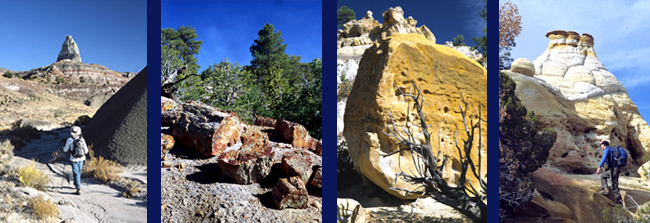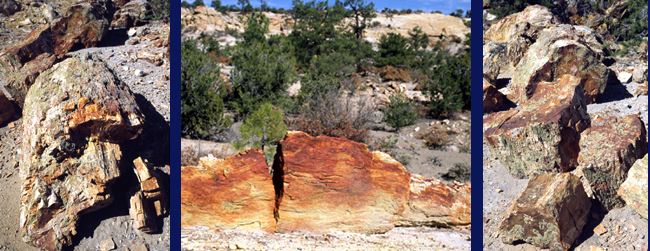
CEJA PELON BADLANDS AND PETRIFIED FOREST
BY MICHAEL RICHIE

FROM : “Ceja Pelon Badlands--Petrified Wood Cache,” New Mexico Magazine , Sept. 2005, with 3 color photos.
For the last several miles I’ve been picking my way through a 60 million year old log jam. Huge petrified tree trunks by the hundreds line the mesa edge. Preserved with exquisite detail, grain patterns and bark textures are rendered in brilliant quartzite colors that span the rainbow. Toppled, 6-7 feet diameter, fluted bases taper into broken trunks. Upright stumps tilt skyward and large sections of trunk rest atop eroded pedestals forming wood capped hoo doos.
This ancient burial ground for fallen conifer monarchs certainly adds to the allure at the Ceja Pelon badlands. Located in the San Juan Basin 20 miles west of Cuba on BLM land, it’s one of what I call the Nacimiento Badlands. Carved from the same widespread San Juan Basin geological formation, Lybrook, Mesa De Cuba, Penistaja, and the Ceja Pelon badlands show similarities but also very distinctive characters. The Nacimiento sedimentary layer accumulated over about a 10 million year span during the Paleocene Period beginning about 65 million years ago. For most of this time, the San Juan basin was a lush forested plain filled with lakes, bogs, and large meandering rivers. Now the tilted, 1000 feet thick sedimentary bed edges are exposed in a huge semi-circle curving across the southern two thirds of the San Juan Basin. Like the other Nacimiento badlands, Ceja Pelon has a stair step topography. Three fairly level steps, the base, the bench, and the mesa top are connected by two 100 feet high, serpentine cliff faces extending for miles along Ceja Pelon Mesa’s south facing edge.

The greatest concentration of petrified wood is on the bench but each level offers interesting formations and hiking. The base holds barren moonscapes formed by a pastel maze of ridges, mounds, washes, and bowls. Low grade coal seams produce rich, crumbling black and grey bands alternating with whites, olives, maroons, and purples. Large pieces of petrified wood litter the wash bottoms. It’s like walking through a Georgia O’Keefe painting where the sensually rounded, raw earth itself appears strangely organic. A steep walled canyon carves deep into the mesa guarded on the right by a dual turreted fortress, on the left by a towering Egyptian obelisk. Even larger petrified wood chunks hint at what lies ahead.

The canyon soon narrows and pinches off into a scramble up to the bench and this incredible collection of petrified wood, the most impressive I’ve seen any where in New Mexico and, in my experience, second only to Petrified Forest National Park. For such an extensive, concentrated buildup conditions must be perfect, beginning with large logs, lots of them, buried in watery mud. Volcanic ash from massive eruptions in the San Juan Mountains on the north helped enrich the coloration and details during the prettification process. The ash provided diverse mineral hues and extra silica to faithfully encase and, in ideal situations, replace the original biological structures over the eons, molecule by molecule, with sparkling, multi-colored glass.
Some of the largest logs stretch for 20-30 feet with broken sections still lined up. Lying sideways, huge curved bases and root masses slowly erode from the earth in various stages of exposure. The route is sometimes completely paved with shattered wood pieces. While other more orderly compositions feature large, individual chunks showcased against a backdrop of soaring, intricately eroded upper mesa walls. Brightly colored boulder slides, hoo doos, and overhanging amphitheaters complete this ornate natural exhibition hall.
After following the highly irregular bench edge for a few miles through the continuous petrified wood cache, I climb the last step up to a much different world on top. Ceja Pelon Mesa is aptly named. Ceja literally means eyebrow but often describes a mesa edge, while Pelon means bald. The bald mesa edge is carved and fractured into all manner of bulbous hoo doos and sharp edged, protruding ramparts. Bonsai ponderosa clutch at bare rock with exposed root claws. The curving grain in venerable juniper trunks mirrors the sinuous, closely spaced parallel lines embossing the smoothly eroded sandstone. Away from the edge, sparse high desert vegetation covers the flat, expansive mesa top. Free standing hoo doos, colored by garish splashes of neon red and tangerine, form a larger than life sculpture park. Scattered petrified wood chunks mark the way.
All these fossil reminders from ancient ecosystems puts my imagination into overdrive. Gazing far south to cylindrical Cabezon Butte, my mind wanders back to the primeval forests that endured here for millions of years so long ago. Then I fast forward into the future wondering what this place will be like 60 million years from now and if that question will still have meaning?

| HOME |
GEOLOGY |
PHOTOGRAPHY TIPS | RECREATION | MAP - INDIVIDUAL BADLANDS |
| INDIVIDUAL BADLANDS PAGE | PHOTO TOURS |
BADLANDS OVERVIEW |
This site is property of PhotoTrekNM. All rights reserved. Copyright 2007.